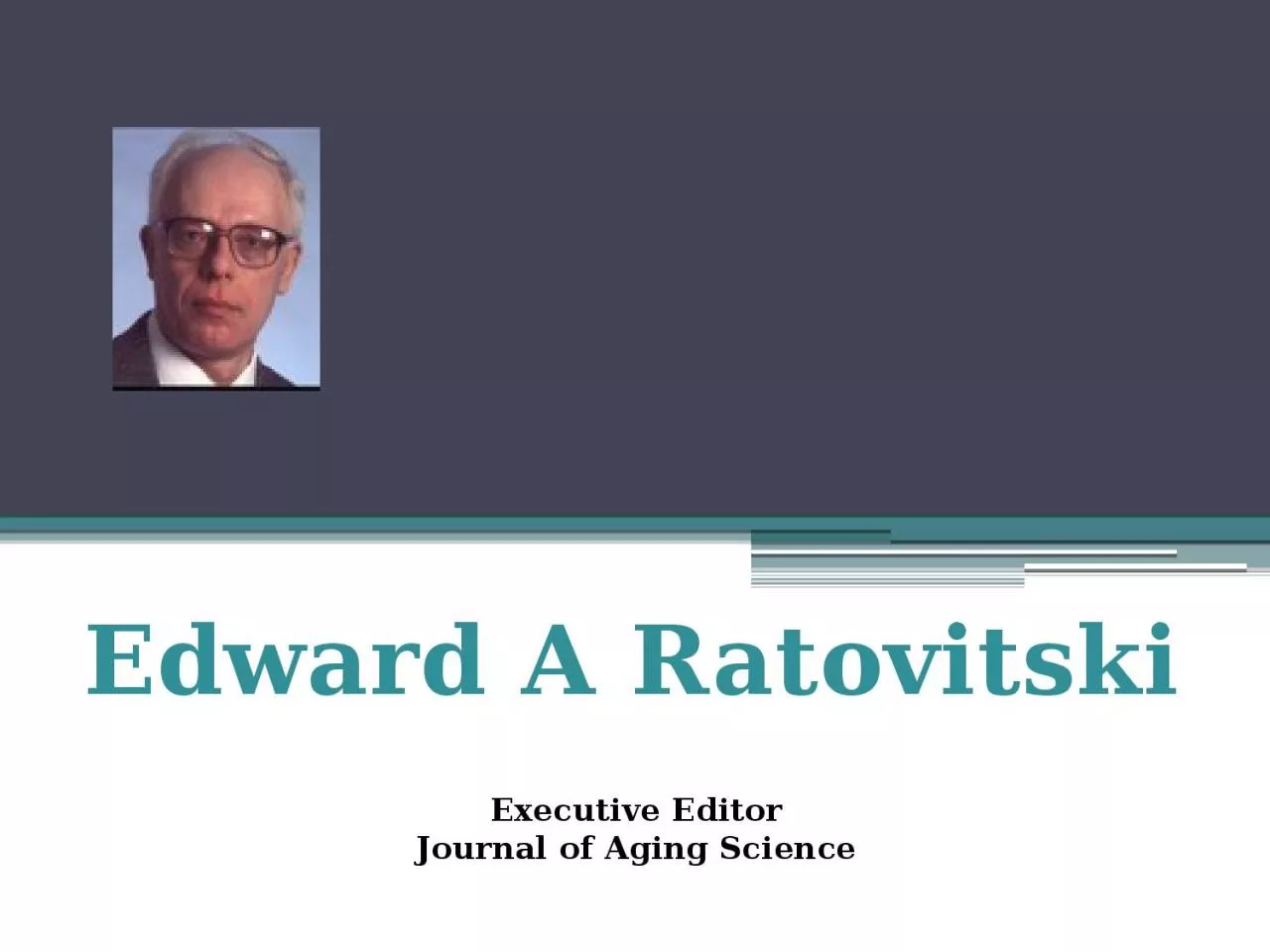

Edward A Ratovitski Biography Dr Edward Ratovitski has received his PhD Degree in Molecular Biology and Cancer Biology from the Petrov Cancer Research Institute Leningrad USSR in 1979 ID: 916922
Download Presentation The PPT/PDF document "Executive Editor Journal of Aging Scienc..." is the property of its rightful owner. Permission is granted to download and print the materials on this web site for personal, non-commercial use only, and to display it on your personal computer provided you do not modify the materials and that you retain all copyright notices contained in the materials. By downloading content from our website, you accept the terms of this agreement.
Slide1
Executive EditorJournal of Aging Science
Edward A Ratovitski
Slide2Biography
Dr. Edward Ratovitski has received his Ph.D. Degree in Molecular Biology and Cancer Biology from the Petrov Cancer Research Institute (Leningrad, USSR) in 1979. In 1990, he started working at the Weizmann Institute of Science (
Rehovot
, Israel), where he studied the interferon type I receptor
signaling
. In 1994, he joined the Johns Hopkins University School of Medicine (Baltimore, Maryland, USA), where he has developed a strong long-lasting interest in protein-protein interactions studies (e.g. MDK and NOS2).
Slide3Biography
Finally he focused on the p63 transcriptional factor implicated in head and neck cancer and ectodermal dysplasia. He has discovered a molecular mechanism underlying ectodermal dysplasia via p63-dependent regulation of RNA splicing for fibroblast growth factor receptor 2, which functions as a key regulator of the epithelial-mesenchymal transition.
His
collaborative efforts with
Drs.
David
Sidransky
and Barry
Trink
led to more than 45 international publications, reviews and patents on p63 function.
Slide4Research Interest
Cancer, ectodermal dysplasia, inflammation, molecular mechanisms of chemoresistance, signaling, protein interactions, protein modifications, transcription, splicing, microRNA, oncogenes and tumor suppressors, p53 family members, NOS2
Slide5Recent Articles
Ratovitski EA (2013) Tumor Protein p63/microRNA Network in Epithelial Cancer Cells. Curr Genomics. 2013 Nov;14(7):441-452. doi: 10.2174/13892029113146660011.
Ratovitski
EA (2014
)
Phospho
-
Δ
Np63
α/
microRNA network modulates epigenetic regulatory enzymes in squamous cell carcinomas
.
Cell Cycle. 2014 Mar 1;13(5):749-61.
doi
: 10.4161/cc.27676.
Epub
2014 Jan 6.
Slide6Dysplasia
Dysplasia is an abnormality of development or an epithelial anomaly of growth and differentiation (epithelial or ectodermal dysplasia).
Slide7Ectodermal Dysplasia
Ectodermal dysplasia is a group of syndromes deriving from the abnormolaities of the ectodermal structures. More than 150 different syndromes have been identified.Worldwide around 7,000 individuals have been diagnosed with an ectodermal dysplasia conditions.Ectodermal dysplasia syndromes are “heritable conditions”, showing the abnormalities of ectodermal structures, such as hair, nails, teeth, sweat glands, cranial-facial structures, digits and limbs and mammary glands
Slide8Tumor protein (TP)-p63 in ectodermal dysplasia
Tumor protein (TP)-p53 family members consist of TP53, the key tumor suppressor, “the guardian of genome”, TP63 and TP73. The genes encoding these critical transcriptional factors play decisive roles in the regulation of cancer and develpmental diseases. While p53 mutations are wide spread among more than 50% of human cancers, mutations in p63 and p73 are quite rare in cancer patients. However, p63 mutations are often found in the patients with ectodermal dysplasia affecting several regulatory pathways and inducing phenotypes of various severity altering development of ectodermal structures and impairing the ectodermal differentiation. At the molecular level, the p63 mutations alter the transcription of important p63 downstream gene targets, RNA splicing, proteasome-dependent degradation of p63 proteins.
Slide9Journal of Aging Science
Aging
Alzheimer
neurodegenerative disorder
Slide105
nd International Conference on Clinical & Experimental Dermatology. April 27-29, 2015 New Orleans, LA, USA
Journal of Aging Science
Related
Conferences
Slide11OMICS Group
Open Access Membership
OMICS publishing Group Open Access Membership enables academic and research institutions, funders and corporations to actively encourage open access in scholarly communication and the dissemination of research published by their authors.
For more details and benefits, click on the link below:
http://omicsonline.org/membership.php